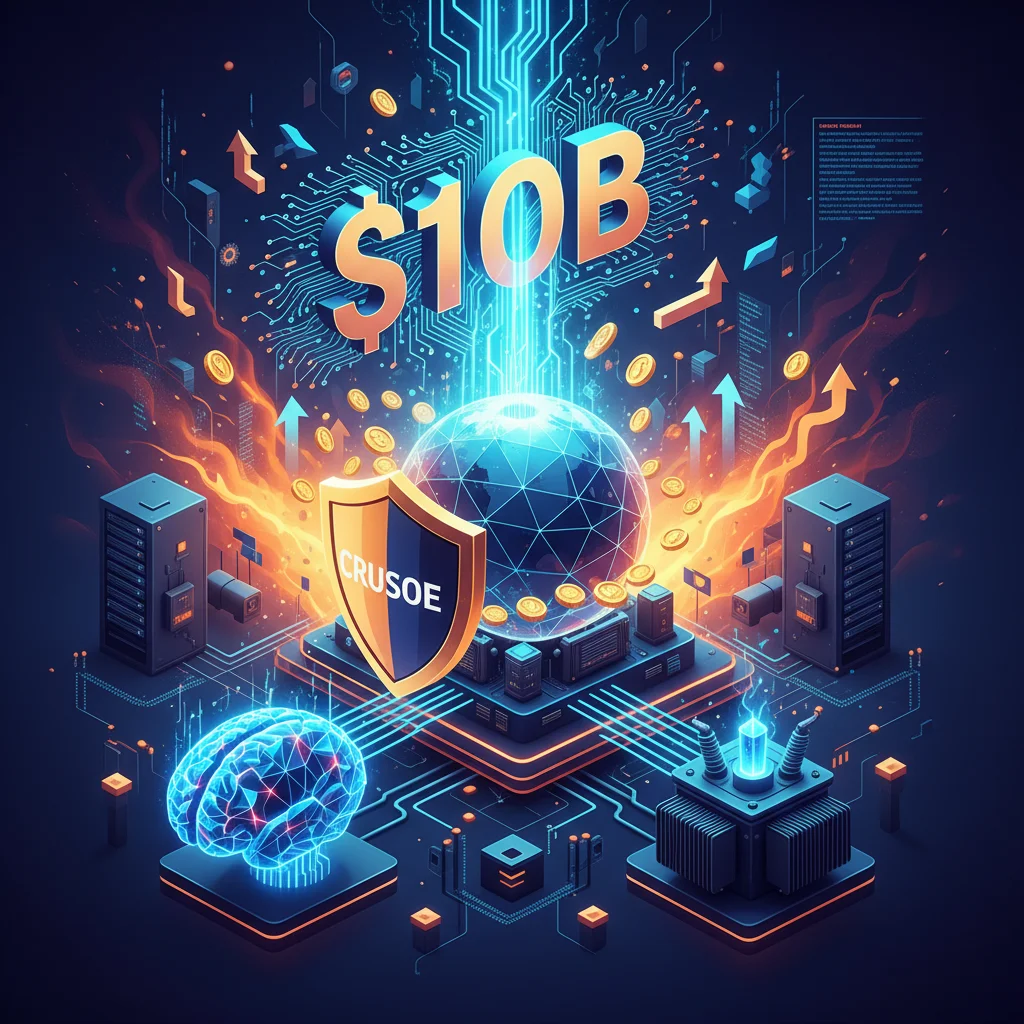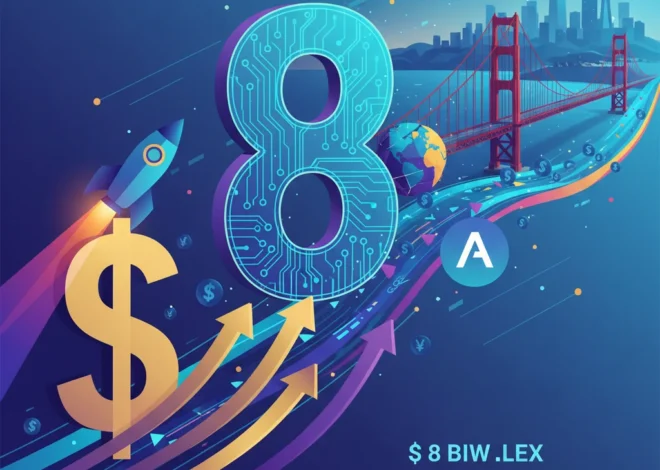
The $10 Billion Bet on AI’s Energy Problem: Why Crusoe’s Funding is a Game-Changer
The artificial intelligence boom isn’t just about brilliant software and mind-bending algorithms; it’s a story of raw, physical power. Behind every stunning image generated by Midjourney and every line of code written by a large language model (LLM), there’s a vast, energy-hungry data center humming with thousands of specialized processors. This insatiable demand for computing power has created a modern-day gold rush, and the biggest winners might not be who you think.
It’s not just the AI model creators who are striking it rich, but the companies providing the “picks and shovels”—the essential infrastructure that makes the revolution possible. In a stunning display of investor confidence, Crusoe, a key infrastructure provider for industry leader OpenAI, has just secured a colossal $1.4 billion in new funding. This investment catapults the company’s valuation to an eye-watering $10 billion, tripling its worth in just one year. This isn’t just another big number in a headline; it’s a powerful signal about the future of AI, the critical challenge of energy consumption, and the innovative startups poised to reshape the tech landscape.
The AI Gold Rush and the Great Compute Crunch
To understand the significance of Crusoe’s valuation, we first need to grasp the sheer scale of the AI industry’s energy appetite. Training a state-of-the-art machine learning model like GPT-4 requires computational power equivalent to millions of dollars in cloud computing credits and consumes more electricity than hundreds of households do in a year. This has led to a global shortage of the high-performance GPUs (Graphics Processing Units), primarily from Nvidia, that are the workhorses of AI.
This “compute crunch” has created a massive bottleneck for innovation. Startups with brilliant ideas are struggling to get the resources they need to train their models, and even established tech giants are in a constant race to secure more capacity. The cloud, once seen as an infinite resource, is showing its limits. This scarcity has opened the door for a new breed of specialized cloud providers focused exclusively on the demanding needs of AI and machine learning workloads.
But building more data centers isn’t a simple solution. They are incredibly expensive to build and even more expensive to power. The global electricity grid is already under strain, and the public is growing more concerned about the environmental impact of technology. This is the critical problem that Crusoe set out to solve, and their unique approach is why investors are lining up to write nine-figure checks.
Is the AI Boom a High-Tech Cargo Cult?
What’s Crusoe’s Secret? Turning Wasted Energy into AI Power
Crusoe isn’t just another data center company; they are an energy-tech innovator first and a cloud provider second. Their groundbreaking idea is to tackle two massive problems at once: the wasted energy from natural gas flaring and the AI industry’s desperate need for low-cost, sustainable power.
Here’s how it works:
- The Problem of Flaring: During oil extraction, natural gas is often produced as a byproduct. If there’s no pipeline infrastructure to transport it, energy companies are forced to burn it off in a process called “flaring.” This wastes a valuable energy resource and releases vast amounts of CO2 and methane—a greenhouse gas far more potent than carbon dioxide—into the atmosphere.
- Crusoe’s Solution: Crusoe builds modular data centers directly at the site of the oil wells. They capture this “stranded” gas before it can be flared and use it to power generators on-site. These generators then provide electricity for their high-density computing racks filled with GPUs, which are then made available to clients like OpenAI over the cloud.
This model is a masterstroke of industrial symbiosis. It provides oil companies with a profitable alternative to flaring, significantly reduces methane emissions, and gives AI companies access to a reliable, low-cost source of power that isn’t straining the public grid. It’s a powerful fusion of environmental responsibility and economic ingenuity that sets them apart from traditional cloud giants.
Decoding the $10 Billion Valuation
A company tripling its valuation to $10 billion in a single year is a rare event that speaks volumes about the market’s belief in its strategy. The $1.4 billion funding round isn’t just a vote of confidence; it’s rocket fuel for expansion at a time when the demand for AI compute is practically vertical.
Let’s look at the numbers and what they signify:
| Metric | Value / Detail | Implication for the Industry |
|---|---|---|
| New Funding Raised | $1.4 Billion | A massive capital injection to aggressively build out new data centers and secure a long-term supply of GPUs. |
| New Valuation | $10 Billion | Places Crusoe among the most valuable private startups in the AI infrastructure space, validating its unique energy-first model. |
| Valuation Growth | Tripled in one year (source) | Demonstrates hyper-growth and intense investor conviction that the AI compute market is still in its early innings. |
| Key Client | OpenAI | Serving the creator of ChatGPT provides immense credibility and a foundational demand for their services. |
This funding isn’t just about building more of the same. It’s about securing a strategic position in the AI supply chain. By controlling a unique, low-cost energy source, Crusoe is building a competitive moat that will be very difficult for traditional cloud providers, who pay market rates for electricity, to replicate.
Spotify's New AI Symphony: Harmonizing with Labels or Composing a Crisis?
What This Means for the Broader Tech Ecosystem
Crusoe’s success story has ripple effects across the entire technology industry, offering key lessons for startups, developers, and established players.
For Startups and Entrepreneurs:
The biggest opportunities aren’t always in building another SaaS application on top of an existing AI model. The foundational layers are ripe for innovation. Crusoe’s success proves that massive value can be created by solving the hard, physical-world problems that enable the software revolution. Entrepreneurs should be asking: What are the other bottlenecks? Is it cooling technology? Data transmission? Cybersecurity for AI models? The “picks and shovels” opportunities are enormous.
For Developers and Tech Professionals:
The era of abstracting away the underlying hardware is meeting its limits. A deep understanding of the full stack—from the silicon in the GPU, to the power and cooling systems in the data center, to the distributed software frameworks—is becoming a superpower. The most valuable engineers and architects will be those who can optimize their code not just for speed, but for energy efficiency and cost. Skills in high-performance computing (HPC), cloud architecture, and even a basic understanding of energy markets will become increasingly sought after.
For Cybersecurity:
As AI models become the “crown jewels” of many companies, the data centers that train and host them become extraordinarily high-value targets. Securing these distributed, and sometimes remote, infrastructure nodes is a monumental challenge. The industry needs a new wave of cybersecurity innovation focused on protecting the integrity of machine learning models from data poisoning, theft, and malicious manipulation at the infrastructure level.
Caught in the Crossfire: Why Europe's Tech Future is Hostage to the US-China Mineral War
The Dawn of a New Infrastructure Era
The rise of Crusoe is a landmark event. It signifies a pivotal moment where the exponential growth of artificial intelligence collides with the physical limits of our energy infrastructure. The $1.4 billion investment is a clear bet that the future of AI isn’t just about smarter algorithms, but also about smarter, more sustainable, and more economically efficient ways to power them.
This is a story of innovation in its purest form—identifying two seemingly unrelated, large-scale problems and creating a single, elegant solution that addresses both. As the AI race intensifies, the companies that can secure and control the cheapest, most reliable sources of power will hold a decisive advantage. Crusoe has fired the starting gun, and the race to build the foundation of our AI-powered future is now well and truly underway.

